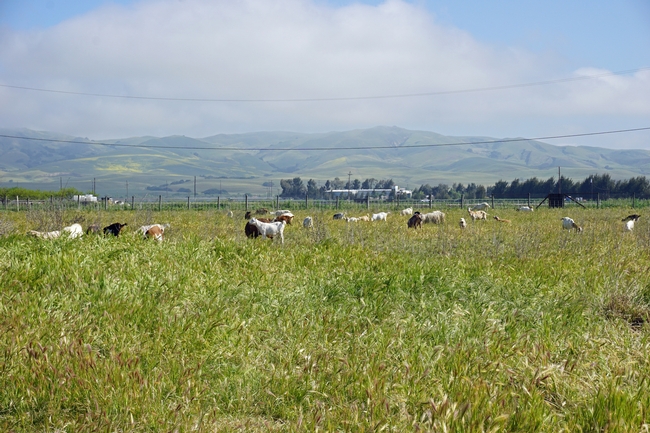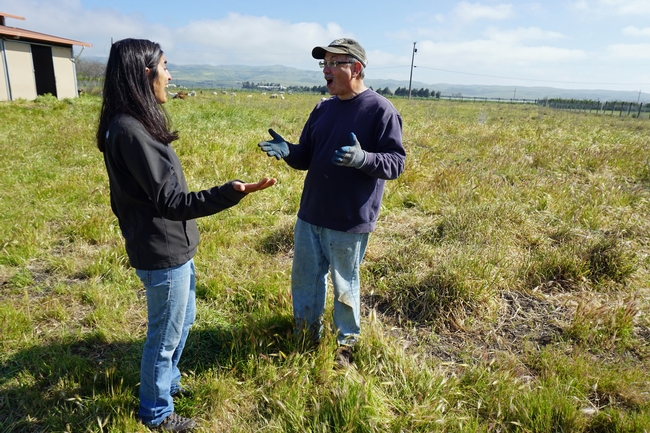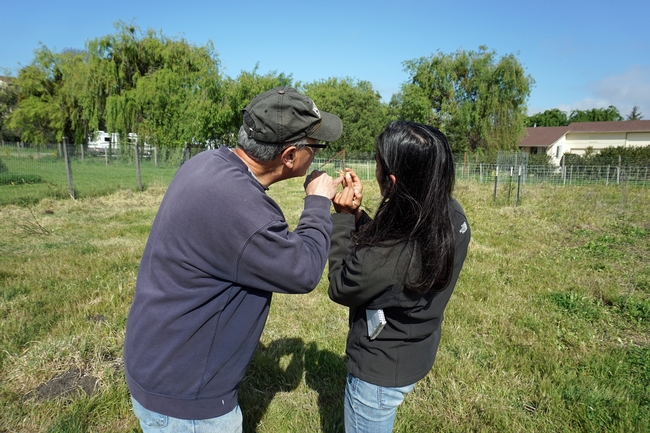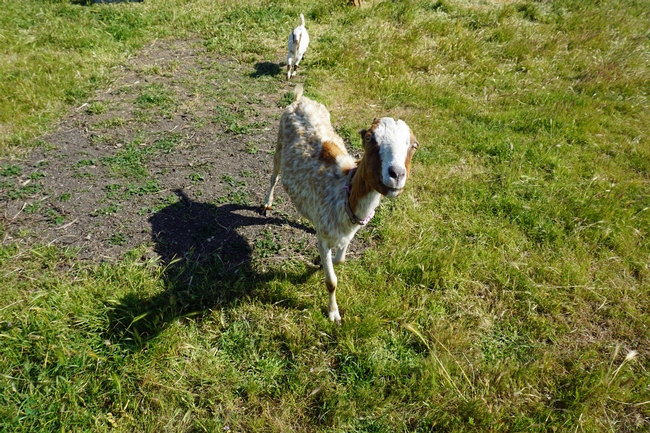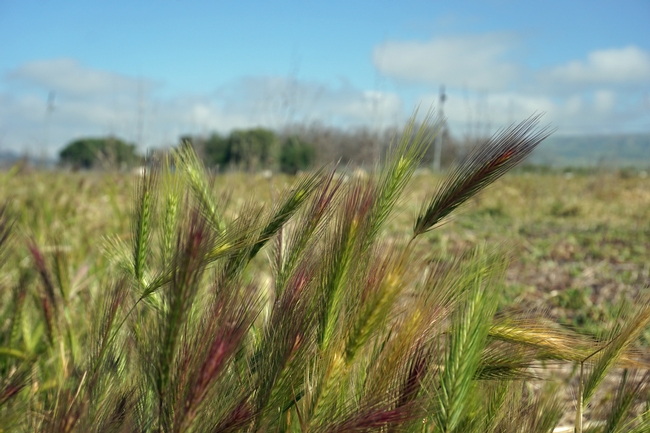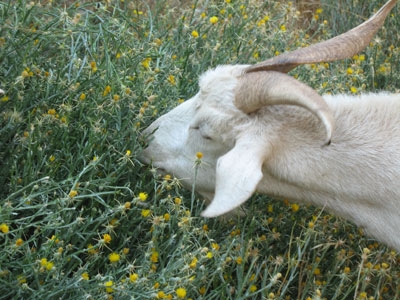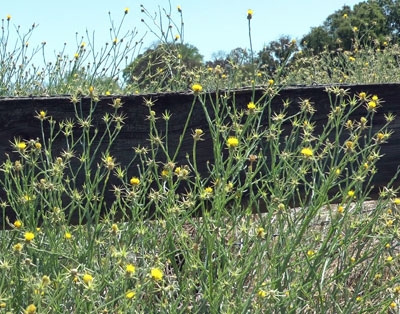Posts Tagged: goats
San Juan Bautista ‘plant nerd’ connects with UC Cooperative Extension
When San Juan Bautista resident Michael Cent was looking for ways to rehabilitate a large backyard pasture infested with invasive foxtail weeds, he called Devii Rao, the UC Cooperative Extension range and natural resources advisor in San Benito County.
Though Rao works mainly with large, commercial producers, she was intrigued by Cent's well thought out plans to replace foxtail with more desirable plants using sustainable practices. She paid him a visit.
Behind the home sits a two-acre fenced pasture where previous owners grazed llamas and ran horses. The picturesque setting adjoins San Juan Creek and frames a panorama of farm fields and the Diablo Mountain Range. But the tableau was spoiled by fence-to-fence foxtails, an exotic plant that hails from the Mediterranean, offers poor forage value and presents nuisance characteristics.
“The seed heads get stuck in the eyes, ears and noses of livestock and pets,” Rao said. “Foxtail is an annual grass that is difficult to control, but that didn't stop Michael Cent from trying.”
Cent is a pharmacist and self-described plant nerd.
“He turned his foxtail problem into a science project,” Rao said.
As a pharmacist, Cent said he is technically a chemist. “When you look at botany as chemistry, if you drill down into all the chemical reactions going on, it's amazing.”
Cent tested the soil Ph and nutrients. He identified 12 plants that would thrive under his pasture conditions and potentially out-compete the foxtails.
“In my research, much of what I see is not native,” Cent said. “My expectations to plant only natives have tempered. It's good to do within reason, but if a benefit of a non-native species outweighs a lesser advantage of being native, I'll go with the non-native species.”
Cent borrowed a tractor to break up the soil and reseeded by hand with his chosen grass and broad leaf plants. He kept detailed notes.
- Birdsfoot trefoil grew a dense carpet that choked out everything.
- Crimson clover germinated and grew quickly early in the season, but didn't do as well as anticipated.
- Harding grass was seeded specifically to out-compete the bristly ox-tongue, another undesirable plant.
- Chicory has a deep taproot, which helps it survive the dry season.
- Oxalis has come in like gangbusters, even though it wasn't seeded.
At first Cent regularly mowed the pasture to keep down the foxtails, but when the job became forbidding, he contracted with a company to bring in goats to aid control.
After four years of effort to overcome foxtail with grazing goats and seeding plants, Cent has come to a realization.
“I thought I could set it in motion and it would take care of itself,” Cent said. “But it's going to take a sustained effort.”
What drives Cent's devotion to rehabilitating a pasture with extensive plant research and management? The miracle of life, he said.
“The marvel of putting a seed in the ground, managing it and seeing what becomes of it. It's fascinating,” Cent said.
Goats can help with yellow starthistle control
Yellow starthistle is thought to have been introduced into California from Chile during the Gold Rush. The weed readily took hold in California valleys and foothills, thriving in areas where the soil has been disturbed by animals grazing, road construction and wildland firebreaks. Today, yellow starthistle is a very common sight in vacant lots and fields, along roadsides and trails, in pastures and ranch lands, and in parks, open-space preserves and natural areas.
Capable of growing six feet tall and bearing flowers surrounded by inch-long spines, yellow starthistle reduces land value, prevents access to recreational areas, consumes groundwater and poisons horses. (Yellow starthistle isn't all bad. Beekeepers have found that it can provide an important late-season food source for bees.)
Large property owners use a variety of methods to control yellow starthistle - chemical, mechanical and biological - but UC scientists believe individual homeowners are a key to containing and eliminating this invasive pest.
That's where goats can come in. Goats will eat yellow starthistle at all phases of growth, including the mature, spiny stage, when it is not palatable to other browsers and grazers.
"When goats eat yellow starthistle, they open up the canopy and allow sunlight to hit the ground," said Roger Ingram, UC Cooperative Extension natural resources advisor. "That allows other, more beneficial seeds to come up and grow. If you can get other plants growing in there, the competition will choke out yellow starthistle."
Landowners can raise goats themselves and direct them to areas of starthistle infestation with portable fencing, or they can lease the animals exclusively for vegetation control. More information on yellow starthistle management is available from the UC Integrated Pest Management Program.
View the video below for more information on goats' browsing preferences.
Read a transcript of the video.
GoatsYST
Goats can be green weed whackers
Interest in using goats to clear unwanted vegetation on rangeland is growing in popularity, according to UC Cooperative Extension livestock farm advisor Roger Ingram. In a Sacramento Bee story published today, Ingram confirmed writer Ramon Coronado's central thesis: Goats can be a green answer to wildfire prevention.
Coronado reported that more than 60 people attended a recent forum where Ingram discussed the pros and cons of using goats instead of machinery, chemicals and weed whackers.
The use of goats for weed abatement has drawbacks, however. Here are some of the concerns:
- Left unchecked, the animals can overgraze, leading to erosion and flash flooding
- The weeds targeted by goats are the first to grow back and the first to dry up and die, which could create more wildfire fuel
- The goats will produce CO2 during their munching and the trucks that deliver and move them around will also contribute to pollution
Ingram countered, according to the story, "You have to look at the big picture."

Goats on rangeland.
Transgenic goats cause a stir
Not surprisingly, a story in yesterday's Sacramento Bee about goats that have been genetically modified with human genes is generating comments on the newspaper's Web site.
The story was prompted by a UC Davis news service press release by Pat Bailey.
In short, UC Davis animal scientists James Murray and Elizabeth Maga engineered a small herd of dairy goats to produce high levels of a human antibiotic-like protein in their milk. Pigs fed milk from the transgenic goats had significantly lower levels of E. coli bacteria in their small intestines than those raised on regular goat's milk. The scientists feel the results mean the goat milk could one day be used to protect or cure people of diseases, especially in poor regions of the world.
Comments on the story ranged from outraged to indifferent to funny.
"Completely disturbing... on so many levels," said one.
"What's disturbing is the irrational fear," wrote another.
"It might be disturbing, but it sure explains a lot about my mother in law," commented a writer.
Those interested in learning the ins and outs of dairy goat production may wish to attend a workshop May 15 in Merced. UC Cooperative Extension farm advisor Deborah Giraud says the market for goat milk is growing due to increasing popularity of specialty goat milk cheese and yogurt. For all the details and registration information, click here.

Dairy goats.


